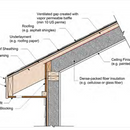Bottom-Ventilated Roof Assembly
Two questions.
In this type of roof assembly, should the roofing underlayment be vapor permeable, or can it be peel n stick (grace etc)? I suppose the ventilation gap means the underlayment could be either, though I’m not sure whether I want to prioritize keeping bulk water out (from ice dams or other) or letting water vapor escape.
I’m primarily interested in insulating the roof because I want to run ducts for a minisplit to the 2nd floor ceilings through the attic. The attic is also accessible by stairs with a large opening, and creating an adequately insulated hatch is basically impossible. Given that the goal is not to make it finished space, but rather just conditioned for the minisplits, do I still need to hit r38+? There’s ~r20ish in the attic between the floor/ceiling joists now.
Thanks!
GBA Detail Library
A collection of one thousand construction details organized by climate and house part










Replies
B Mac,
With asphalt shingles you won't get any appreciable drying to the exterior. You should definitely prioritize stopping bulk water intrusion. That said, using a peel & stick on the whole roof is overkill. Any impermeable synthetic membrane will do.
These hybrid roofs with insulation at both the roof plane and the attic floor can be tricky. You need to condition them enough to avoid moisture issues, which can negate a lot of the usefulness of the insulation below. My inclination would be to try and get close to the R-38, but not stress about it.
So if there's no drying to the exterior on an asphalt roof, any drying is contingent on movement of air through the ventilation gap? Sounds like 1 inch is code acceptable, but ~2 is better?
I'm thinking a good assembly might be 1. painted drywall (no penetrations), 2. several inches of polyiso with sealed seams, 3. rockwool batts between rafters to avoid settling or bowing the baffles, then 4. a 1.5-2 inch ventilation gap constructed from 1/4" plywood or taught stapled wrb (typar/tyvek/felt - is higher perm better?).
I'm in MA, so cold winters, hot summers. This assembly seems solid for the winter by preventing warm moist air from reaching the roof sheathing (100 yr old tongue and groove), with the rockwool/ventilation gap as the backup if it gets through the foam. But during the summer if the attic is cooled, what's the condensing surface for inward vapor drive?
B Mac,
There is some drying through the shingles. A very small amount, which is dwarfed by the drying through the vent channels. When RDH looked at this they concluded that the small amount of drying upwards was insignificant compared to the risk of bulk water intrusion from above, and so suggested an impermeable underlay made the most sense.
Yes a 2" gap is more effective than a 1" one. It contains more air to dilute moisture and allows more air to flow through it.
That sounds like a good roof assembly. The interior foam should protect it from condensation concerns in the summer. It is assembly #2 in this article: https://www.greenbuildingadvisor.com/article/five-cathedral-ceilings-that-work
It is necessary to make a proper vent. Otherwise, the roof will leak in strong winds. Read more information here: https://tornadoroofing.com/ridge-vent-pros-and-cons/